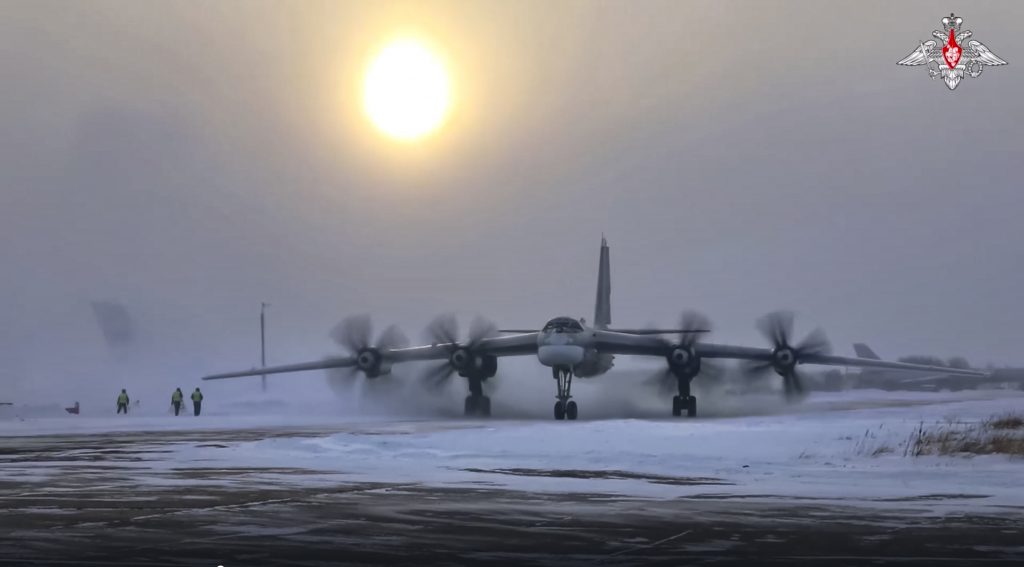Arctic Russian airbase “undoubtedly” on radar of Ukrainian armed forces: expert

The Olenya airbase is undoubtedly on the radar of Ukrainian armed forces, says an expert after a wave of bombers from the Kola Peninsula again launched a massive cruise missile attack on Ukraine, the third since Christmas.
Ukraine’s Air Force early Monday morning reported on Telegram that 13 Russian strategic bombers had taken off, of which nine came from Olenya airbase.
Located inside the Arctic Circle, the airbase is as far from Ukraine as it is possible to come in the European part of Russia.
A few hours after take-off, the Tu-95 warplanes launched their deadly loads, typically four cruise missiles each, against targets in four oblasts in Ukraine. Although most were shot down, a few hit their targets including in Kharkiv, Ukraine’s second-largest city.
4 civilians were killed and 33 more injured in the attack.
Monday’s massive air strike was the third in just over a week as Moscow intensifies its war of hitting civilian infrastructure and apartment blocks. Russia’s state-controlled propaganda agency TASS claims the missiles were targeting Ukrainian military-industrial complex facilities.
Like the attacks on December 29 and January 2, most planes came from Olenya just south of Murmansk. It was last spring the strategic air forces relocated more than 10 Tu-95M and Tu-160 long-range bombers to Olenya. The move came after Engels airbase in Saratov region was hit by Ukrainian drones.
Murmansk region under scrutiny?
In August 2023, also six Tu-22M3 were relocated from Soltsy-2 airbase in Novgorod region to Olenya after at least one plane was damaged by fire after an attack. Soltsy-2 is 650 km away from Ukraine.
A key question, however, is for how long are the bombers safe in the Murmansk region.
Olenya airbase is more than 1,800 km from Ukraine, but it is well known that sabotage groups are operating inside Russia.
“A recent example is last week’s torching of a Su-34 fighter-bomber at the Shagol air base in Chelyabinsk,” says Kristian Åtland, a senior researcher at the Norwegian Defence Research Establishment.
“This is well east of the Ural mountains. Something similar could in theory happen at bases located further from the Ukrainian theater of operations, including the Kola Peninsula,” Åtland says to the Barents Observer.
The Olenya airbase is undoubtedly on the radar of the Ukrainian armed forces, says Katarzyna Zysk, a professor at the Norwegian Institute of Defence Studies.
“Given that Ukrainian operatives are in Russia, one cannot exclude a sabotage or another form of attack to, first of all, undermine the Russian military capability, as well as to humiliate Moscow as a measure of psychological warfare,” Zysk says.
Another dimension to regional tensions
She adds that sabotage actions would be challenging to carry out due to the region’s remoteness and climatic conditions.
But as strikes on civilian objects in major Ukraine cities continue with a majority of the bombers coming from the Russian north, risks of drone attacks or sabotage actions increase.
“Needless to say, the Ukrainians want the Russian air attacks to stop, and they are using all available means to bring them to a halt,” Kristian Åtland says.
“It is natural to assume that they are looking at all parts of the Russian ‘kill chain’, including the ground infrastructure.”
There are several weapons storage and readiness facilities near the airbase, including the location where cruise missiles arrive by train.
All the Tu-95, Tu-160 and Tu-22M3 planes are parked by the aprons, in the open. So are the tankers for aerial refueling.
Professor Zysk says a potential attack on Olenya airbase could contribute to increased regional tensions.
“It would certainly invite stronger protective measures from Russia and could be used to spread theories about Western involvement, thus alleviating the humiliation and exploiting the event to garner public support or at least weaken the criticism,” she says.
“Depending on the circumstances of the attack, if Russia would have doubts about a possible indirect Western support, it could contribute to increased regional tensions, not least in the context of changes taking place in the strategic landscape following Finland’s and soon Sweden’s joining of NATO,” Katarzyna Zysk says to the Barents Observer.
Related stories from around the North:
Canada: U.S. report claims Trudeau told NATO Canada will never meet military spending target, CBC News
China: Satellite imagery reveals construction progress on new Chinese Antarctic base, Eye on the Arctic
Finland: Russian cyber attacks, espionage pose growing threat to Finnish national security, Yle news
Greenland: Growing focus on Arctic puts Greenland at higher risk of cyber attacks: assessment, Eye on the Arctic
Iceland: Iceland authorizes U.S. submarine service visits, Eye on the Arct
Norway: Norwegian Air Force starts training of Ukrainian personnel, The Independent Barents Observer
Russia: Russia’s brand new warship heads to Arctic base, The Independent Barents Observer
Sweden: Swedes must mentally prepare for war, says military top brass, Radio Sweden
United States: U.S. nominates Alaskan as first Arctic ambassador, Eye on the Arctic



